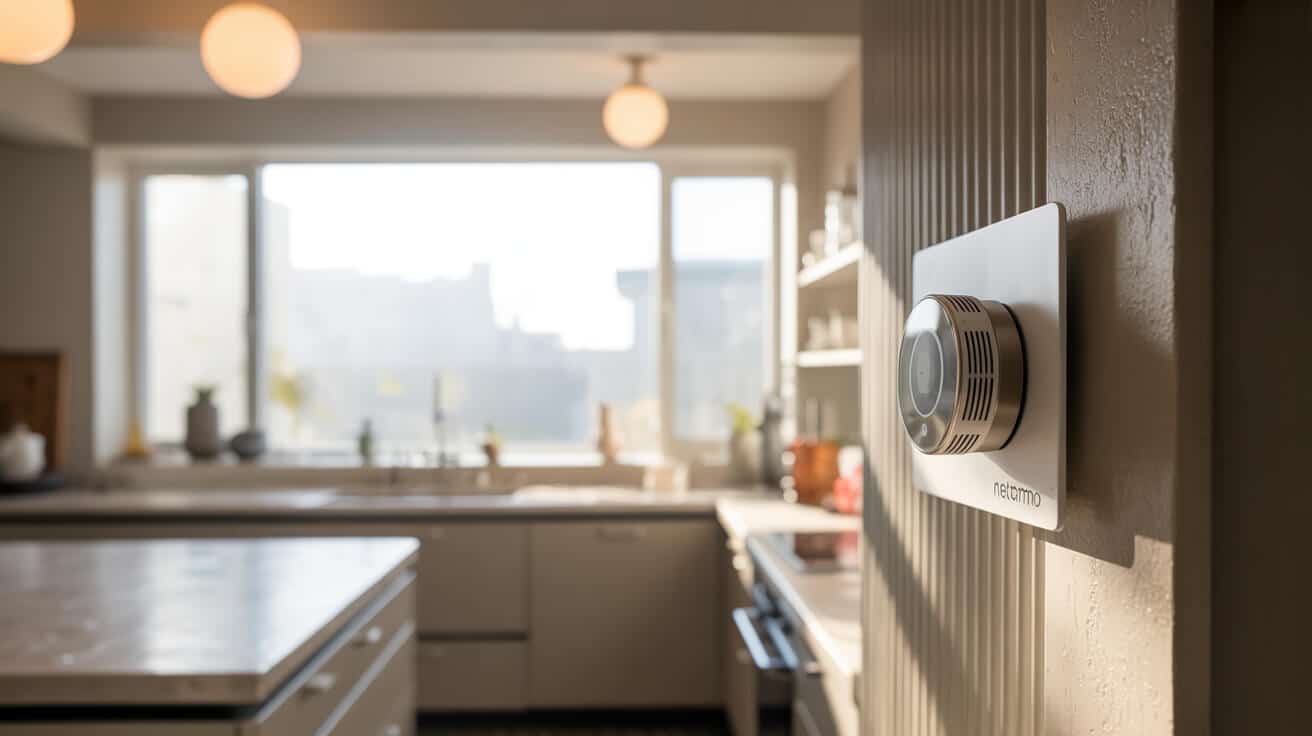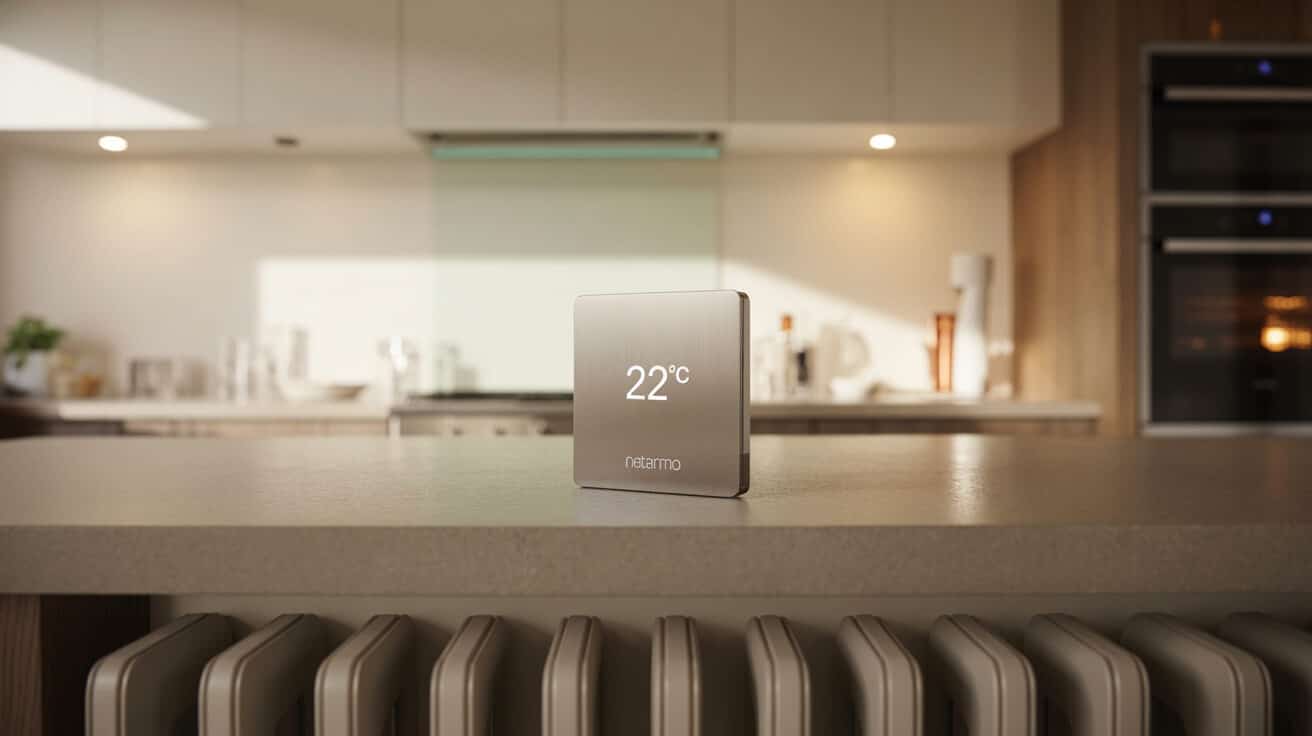Netatmo’s system features modular wireless technology designed to interface with a wide array of heating systems via a central thermostat and relay. Its integration with app-based controls, digital assistants, and property management platforms enhances user agency—enabling precise heating management whether you occupy, rent, or oversee property portfolios. The device’s evolution reflects a wider industry shift from manual to automated heating management, supporting both regulatory compliance and energy consumption transparency.
Etymology or name origin
The term “Netatmo” merges “network” and “atmosphere,” aligning with the product’s goal of enabling network-driven climate regulation. “Smart thermostat” as a designation distinguishes programmable and connected controls from traditional manual or dial-based thermostats, reflecting the progression towards intelligent building controls in the heating services industry.
Overview / context
smart thermostats have transformed the approach to central heating control in plumbing and heating practice. Previously dominated by manual wall dials or simple timed switches, property heating today often centres on digital control devices, customizable from your smartphone or tablet. Professional assessment of your property’s needs by companies including Plumbers 4U ensures systems are fully compatible with the existing heating infrastructure and deliver optimal results. Increasing regulatory emphasis on efficiency, combined with consumer demand for flexible control and transparency, has positioned connected controls as a mainstay in modern property management.
For homeowners, digitised controls offer tangible energy savings and simplification of comfort management. Landlords and property managers benefit from remote status monitoring, usage transparency, and tenant support—mitigating operational risk and supporting evidence-based regulatory compliance in multi-occupant settings.
Plumbing and heating firms have adapted their service models to include site assessments, system design, installation, commissioning, handover, and ongoing support for connected heating solutions. This has elevated the profession’s application of system diagnostics, compliance documentation, and digital client education.
History
Origins
The programmable heating controller first found widespread adoption in European and North American homes during the 1980s, as electronic timers and temperature sensors replaced purely mechanical thermostats. The need for programmable schedules and early attempts at energy optimization marked the movement’s beginnings.
Industrial emergence
Advancements in microprocessors, wireless communications, and standardised relay protocols in the early 2000s set the stage for fully digital, user-configurable heating controls. Manufacturers such as Netatmo and its competitors entered the market with products offering non-local access, energy monitoring, and data aggregation, moving beyond simple temperature setting to algorithmic environmental regulation.
Contemporary evolution
Today’s smart thermostats are typically installed by certified professionals and are compatible with building regulations in many jurisdictions. Features such as app-based configuration, integration with voice assistants, and predictive behaviour algorithms have made these devices the preferred choice in both new-build and retrofit scenarios. Industry expansion continues as your organisation’s need for system resilience, performance data, and client-facing comfort increases.

Concept / description
Core functions
A Netatmo Smart Thermostat is designed to replace existing thermostatic controls with a digital, programmable unit that automates heating scheduling and temperature zoning. It collects indoor temperature and occupancy data, adapting heating patterns to suit the resident or facility manager’s schedules.
Device architecture
The system includes:
- A digital display thermostat for user-facing interaction.
- A wireless relay, typically connected to your heating system’s boiler or zone valve, facilitating command transmission.
- Optional smart radiator valves to extend control to individual rooms or spaces.
- Mobile and web applications for remote programming, status monitoring, and usage reporting.
Data and adaptation
The thermostat’s firmware regularly updates via secure cloud connections, and learning algorithms adjust patterns over time. System sensors detect temperature swings, open windows, or extended absences—modulating heat to maximise comfort and efficiency.
Security and permissions
Access is permission-driven, supporting multi-user roles for household members or your maintenance team. For multi-unit properties, managers may assign usage rights and restrict scheduling overrides as necessary.
Compatibility
The device’s relay supports two-wire (on/off) and OpenTherm (modulating) boiler connectivity, maximising system fit across UK and EU markets. Legacy system retrofits may require auxiliary wiring or range extenders in properties with thick construction walls.
Functionality / purpose / applications
Scheduling and temperature management
Smart thermostats enable heating schedules tailored to your lifestyle, business hours, or occupancy cycles. Multiple zones or rooms can be programmed independently, allowing for different comfort profiles.
Remote and adaptive access
Mobile applications allow you to make real-time adjustments, view analytic reports on usage, and receive alerts for system anomalies—providing reassurance whether you manage your own property or a wider portfolio.
Target user groups
- Homeowners optimise comfort and save on energy costs by customising schedules and monitoring heat use.
- Landlords improve tenant satisfaction and facilitate compliance with Minimum Energy Efficiency Standards without manual intervention.
- Facilities managers and commercial property directors gain comprehensive oversight of heating systems across multiple sites, reducing operational interruptions and human error.
Energy analytics and resource management
The device’s analytic features forecast energy costs, recommend schedule changes, and enable monitoring for anomalies in heating demand—aligning with your sustainability or cost-reduction targets.
Tenant and occupant support
Training and support from professional service providers ensure non-technical users are confident managing device routines, and documentation is retained for future reference or regulatory checks.
Classifications / types / variants
Device categories
Systems can be classified as:
- Standalone programmable thermostats used for single-room or zone management.
- Expandable solutions offering integration with smart radiator valves, extending control to any room.
- Models optimised for modulating boilers via OpenTherm, or more basic on/off relay control.
Power and physical configuration
Netatmo and similar brands offer battery-powered thermostat modules alongside mains-powered options, providing flexibility for your existing electrical and mechanical infrastructure.
Platform compatibility
Variants differ in the level of compatibility with popular voice assistants, web platforms, and system integration with broader home automation or building management solutions.
Systems / tools / methodologies
Assessment and installation
certified engineers conduct property assessments to confirm compatibility, relay placement, and wireless signal strength before installation. The relay wiring follows safety protocols aligned with your boiler and zone valve specifications.
Commissioning
Once installed, thermostats are connected to your Wi-Fi network, device pairing is validated, and control is handed over to you via a personalised digital onboarding session. App tutorials, digital guidebooks, and aftercare schedules are provided for continuing support.
Diagnostics and maintenance
Plumbers 4U utilises specialist diagnostic tools, enabling predictive software checks, firmware upgrade validation, and real-time troubleshooting throughout your device’s lifecycle.
Training and handover
At commissioning, your company receives an orientation on using the scheduled programmes, remote app access, temperature overrides, and energy analytics dashboards, streamlining ongoing performance monitoring.

Stakeholders / entities involved
Manufacturers and design firms
Netatmo (Legrand Group) maintains device design, software development, and supply partnerships with regional distributors and major plumbing merchants.
Installation and service professionals
Gas-safe and manufacturer-certified engineers perform installations, maintenance, and diagnostics necessary to ensure optimal operation for your heating system.
Customers and end-users
User groups include private homeowners, single- or portfolio landlords, and property managers responsible for large or complex estates, as well as commercial facilities teams seeking consistent and compliant heating control.
Regulatory and warranty infrastructure
Product standards bodies, compliance officers, and warranty management services contribute to ongoing device validation, incident tracking, and sector-wide best practice updates.
Legal / regulatory / ethical considerations
Regulation and compliance
Devices must be fitted in accordance with building standards such as Part L for energy efficiency and Boiler Plus in applicable regions. Manufacturer and installation warranties stipulate professional installation as a requirement for validity.
Testing and certification
Smart thermostats undergo product compliance testing for electrical safety, electromagnetic compatibility, and interoperability with common heating system standards (notably OpenTherm).
Privacy and data stewardship
Usage and environmental data collected by the device are subject to strict privacy rules, including GDPR. Consent for behavioural and performance data collection must be obtained from you or your company prior to cloud-based transmission or storage.
Service and warranty
Improper installation, non-compliance with regulations, or unauthorised access may compromise both user safety and your device’s warranty. Ongoing maintenance and support agreements—offered by companies such as Plumbers 4U—help ensure consistent compliance.
Performance metrics / data / measurements
Energy management and efficiency
Devices are assessed based on the reduction of heating hours, measured energy savings versus baseline scenarios, and alignment with expected efficiency gains as projected by national standards.
User experience and support
Metrics track app reliability, onboarding success rates, and frequency of support requests logged by your users or facilities support staff.
Reliability, maintenance, and quality
Key performance data include average battery life, relay connectivity uptime, firmware update success, and the incident rate of sensor or module failure.
Comfort and satisfaction
Improved comfort is documented through reductions in occupant complaints, more consistent temperature delivery, and positive satisfaction reports from householders, tenants, and building operators.
| Metric | Description | Typical Range (UK Market) |
|---|---|---|
| Energy savings | Reduced boiler runtime | 10–20% vs non-programmable controls |
| App reliability | Successful commands, crash rate | >95% success, <2% crash (monthly avg) |
| Comfort satisfaction | Lower complaints, improved comfort | 80–90% satisfied (surveyed occupants) |
| Battery life | Signal interval, zone count | 1–2 years for standard usage |
| Connectivity uptime | Relay connection, Wi-Fi dropouts | 97–99% typical monitored installations |
Challenges / barriers / limitations
Technical and structural challenges
Legacy wiring, substantial wall mass, or older heating system protocols may require supplementary relays, wiring upgrades, or customised installation methodology.
Compatibility and user onboarding
Proprietary system architectures or mixed heating controls can disrupt straightforward integration, necessitating careful configuration and post-instal testing.
Adoption and user experience
Digital comfort controls require learning on the part of you and your clients; inconsistent digital literacy or lack of multi-language support can impede optimal usage, particularly in multi-resident or commercial cases.
System resilience
Wi-Fi and relay connectivity failures can hinder remote access, making local manual override and failsafe routines essential.
Regulatory evolution and uncertainty
Rapidly developing standards in both device capabilities and documentation requirements place ongoing demands on you as a facilities or compliance operator to remain up to date.
Impact / influence / legacy
Elevation of heating control standards
Routine installation of smart thermostats by professional service providers has led to a new baseline for what occupants, landlords, and property operators expect from heating systems.
Value transformation for service providers
Plumbers 4U and similar companies have evolved from basic instal-and-repair models to technology partners offering full lifecycle commissioning, client training, and digital troubleshooting—often embedding ongoing device monitoring and analytics support into your property agreements.
Asset and regulatory management
Automated system reports, transparent scheduling, and proactive support facilitate risk management, legal compliance, and your asset optimization—especially for portfolio landlords and managed sites.
Sector energy and sustainability outcomes
National adoption of advanced heating controls substantially contributes to broader energy and greenhouse gas reduction targets, with installed device bases supporting real-world study of heating usage and optimization impact.
Professional credentialing and industry norms
The proliferation of programmable, connected thermostats has shifted the required skill set for installers and property managers, making digital competence and diagnostic proficiency a standard for your trusted partners.
Future directions, cultural relevance, and design discourse
Integration with renewables and hybrid systems
Smart thermostats are expected to play a pivotal role in supporting your adoption of heat pumps, solar thermal, and hybrid heating, with seamless integration enabling flow temperature adaptation and coordinated scheduling.
Predictive, adaptive controls
Advancements in AI-driven schedules may soon enable predictive, fully automated heating adjustment based on your occupancy, outdoor conditions, and historical trends.
Evolving regulation and market forces
Rising regulatory standards, energy benchmarking schemes, and asset transparency mandates are anticipated to further shape device design, installation protocols, and reporting tools.
Accessibility and user-centric design
Next-wave product development emphasises inclusive user interfaces, accessibility features for elderly or vulnerable users, and robust multilingual support—ensuring your property’s system usability regardless of occupant technical acumen.
Socio-cultural meaning and symbolism
As a visible emblem of digital autonomy, energy-awareness, and environmental stewardship, the Netatmo Smart Thermostat reflects a wider societal shift towards responsible and intelligent resource management.
Digital trust, control, and boundaries
Ongoing industry and research dialogues consider the fine balance between your convenience through automation and the ethical need for device transparency, privacy, and local control.

